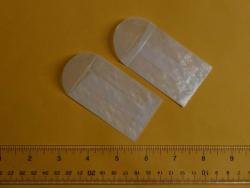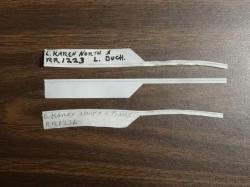I do use an assortment of soft hair or bristled paint brushes to perform the actual pollination. Many species lilies (and most hybrids) are copious pollen producers, but some species, not so much. Little pollen, little brush. You'll want to use every pollen grain possible.

If you use coin envelopes for pollen, make sure the pollen can't escape at the corners where the flap folds, and make sure also that the other two corners are sealed. These envelopes were not made for something as tiny as pollen, and are not manufactured to such specifications. I use glassine envelopes for such applications, and make a different fold to close the flap and insure no escapees. The lower envelope has the original manufacturer's fold. The upper one has mine.

The little ziplock plastic bags can be found at craft stores, too, and even Walmart.
I never thought about paint pens being oil based or otherwise, so I had to look at mine.... my pen says "xylene" based.

My testing has gone three years also, and it is holding up as well as my old standby: pencil graphite.
My pollination tags are ready made, twisty and all. They are the type one usually sees at the food stores where you get grains, etc. in bulk. They easily hold up to outside conditions for the one growing season.

Della, it never would have occurred to me that using such a thin piece of tinfoil would be a viable option. Necessity is indeed the mother of invention!
I am not completely sold on the notion that seed production necessarily reduces bulb size or reduces the ensuing year's productivity. In my opinion, although this is the safe generalization to stand by, this may or may not be true, depending on many variables (i.e. inherent vigor, amenable growing conditions, plant age, climate, seasonal conditions, etc.). I am not aware of any studies done with lilies, but there are several that prove that more ephemeral species bulbs, like tulips, fritillaria and daffodils, actually grow
larger bulbs if allowed to produce seed. This is because when these species produce seed, they stay green longer through the summer (and produce more food) than ones that do not produce seed. Tulips and fritillaria are both in the same family as Lilies (Liliaceae), and Fritillaria is closely related to Lilium.
---- Though I have not investigated bulb growth, I do find this to be the case with my moisture loving species (Lilium michiganense and L. canadense). Since no part of my gardens is conducive to their moisture wants, unpollinated plants usually senesce in late summer, while pollinated plants with seed pods stay green into the fall.


